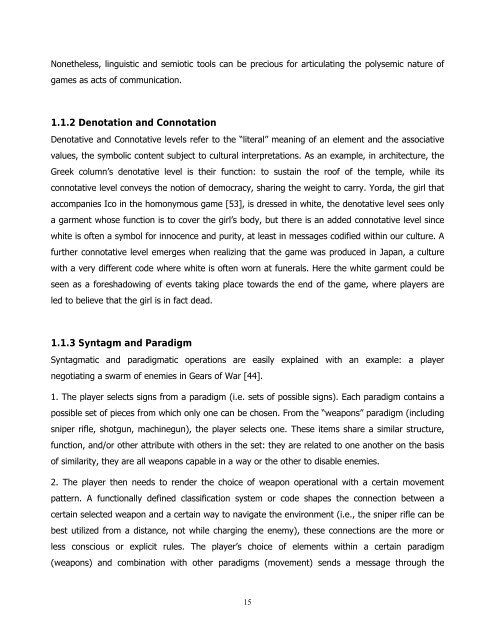Play-Persona: Modeling Player Behaviour in Computer Games
Play-Persona: Modeling Player Behaviour in Computer Games
Play-Persona: Modeling Player Behaviour in Computer Games
Create successful ePaper yourself
Turn your PDF publications into a flip-book with our unique Google optimized e-Paper software.
Nonetheless, l<strong>in</strong>guistic and semiotic tools can be precious for articulat<strong>in</strong>g the polysemic nature of<br />
games as acts of communication.<br />
1.1.2 Denotation and Connotation<br />
Denotative and Connotative levels refer to the “literal” mean<strong>in</strong>g of an element and the associative<br />
values, the symbolic content subject to cultural <strong>in</strong>terpretations. As an example, <strong>in</strong> architecture, the<br />
Greek column’s denotative level is their function: to susta<strong>in</strong> the roof of the temple, while its<br />
connotative level conveys the notion of democracy, shar<strong>in</strong>g the weight to carry. Yorda, the girl that<br />
accompanies Ico <strong>in</strong> the homonymous game [53], is dressed <strong>in</strong> white, the denotative level sees only<br />
a garment whose function is to cover the girl’s body, but there is an added connotative level s<strong>in</strong>ce<br />
white is often a symbol for <strong>in</strong>nocence and purity, at least <strong>in</strong> messages codified with<strong>in</strong> our culture. A<br />
further connotative level emerges when realiz<strong>in</strong>g that the game was produced <strong>in</strong> Japan, a culture<br />
with a very different code where white is often worn at funerals. Here the white garment could be<br />
seen as a foreshadow<strong>in</strong>g of events tak<strong>in</strong>g place towards the end of the game, where players are<br />
led to believe that the girl is <strong>in</strong> fact dead.<br />
1.1.3 Syntagm and Paradigm<br />
Syntagmatic and paradigmatic operations are easily expla<strong>in</strong>ed with an example: a player<br />
negotiat<strong>in</strong>g a swarm of enemies <strong>in</strong> Gears of War [44].<br />
1. The player selects signs from a paradigm (i.e. sets of possible signs). Each paradigm conta<strong>in</strong>s a<br />
possible set of pieces from which only one can be chosen. From the “weapons” paradigm (<strong>in</strong>clud<strong>in</strong>g<br />
sniper rifle, shotgun, mach<strong>in</strong>egun), the player selects one. These items share a similar structure,<br />
function, and/or other attribute with others <strong>in</strong> the set: they are related to one another on the basis<br />
of similarity, they are all weapons capable <strong>in</strong> a way or the other to disable enemies.<br />
2. The player then needs to render the choice of weapon operational with a certa<strong>in</strong> movement<br />
pattern. A functionally def<strong>in</strong>ed classification system or code shapes the connection between a<br />
certa<strong>in</strong> selected weapon and a certa<strong>in</strong> way to navigate the environment (i.e., the sniper rifle can be<br />
best utilized from a distance, not while charg<strong>in</strong>g the enemy), these connections are the more or<br />
less conscious or explicit rules. The player’s choice of elements with<strong>in</strong> a certa<strong>in</strong> paradigm<br />
(weapons) and comb<strong>in</strong>ation with other paradigms (movement) sends a message through the<br />
15















